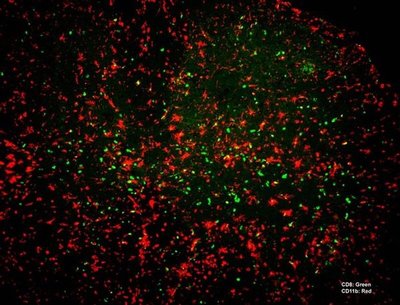June 10, 2010
Virus infection may trigger unusual immune cells to attack the brain and spinal cord in multiple sclerosis
A virus infection can incite the body to attack its own nerve tissue by activating rare, disease-fighting cells with receptors for both viral and nerve proteins. The dual-receptor observation suggests a way nerve damage might be triggered in susceptible young adults afflicted with multiple sclerosis (MS).
University of Washington Department of Immunology scientists Qingyong “John” Ji, Antoine Perchellet, and Joan M. Goverman conducted the study, which was published this week in Nature Immunology.
This is thought to be the first study to reveal a mechanism for autoimmune disease that depends on destroyer immune cells expressing dual receptors for a normal protein made by the body and a pathogen.
Multiple sclerosis is one of many autoimmune disorders in which the body’s lines of defense become misguided and start damaging normal tissue. In the case of multiple sclerosis, the protective sheath around major nerves — the myelin — in the brain and spinal cord disintegrates. Like a frayed electrical cord, the nerves no longer transmit a clear signal.
People with multiple sclerosis might lose their ability to see, walk, or use their arms, depending on which nerves are affected. The symptoms can appear, disappear, and re-appear. The disease is more common in women than in men.
In healthy people, the immune system is kept in check to tolerate the usual proteins and cells in the body, much like an eager watch dog is put on a leash and trained to ignore friends and neighbors, yet still protect the family.
“Autoimmunity is believed to arise from an accidental breakdown in this tolerance of the body’s own proteins. This breakdown is triggered by something in the environment, most likely a pathogen,” noted Goverman, professor and acting chair of immunology whose research concentrates on the origins of autoimmune disease. Her lab is studying mechanisms that maintain tolerance, as well as the “tripping” mechanisms that defeat it.
In their most recently published study, her research team genetically engineered mice that over-produce a certain type of white blood cell from a group known as killer T cells. The normal function of killer cells is to attack tumor cells or cells infected with viruses or other pathogens. These T cells have receptors that recognize specific proteins that infected cells display to them, much like holding up a target in a window.
The specific killer T cells examined in this study were CD8+ T cells. The Goverman lab engineered mice to over-produce CD8+cells that recognized myelin basic protein, a predominant protein in the myelin sheath that covers nerves. The major question investigated in the study was whether the genetically engineered mice would exhibit a disease that resembled multiple sclerosis.
The researchers infected the mice with a virus that has itself been engineered to produce myelin basic protein. This infection should activate the CD8+T cells to first attack the virally infected cells making myelin basic protein to eliminate the virus, then kill other cells that make myelin basic protein to wrap around nerves. Killing those cells would destroy the myelin sheath.
As expected, the mice developed a multiple sclerosis-like disease. But the researchers were surprised when viruses lacking the myelin basic protein also triggered the disease.
Additional cross-breeding experiments revealed the existence of two receptors on a few of the CD8+T cells. These cells, engineered specifically to bind to myelin basic protein, also built their own receptors for viruses, and could recognize both. When exposed to cells infected with viruses, they would bind to and destroy them using one receptor. Geared up as if they were beserk, some of these double-agent cells then would head elsewhere to bind their other receptor to cells producing myelin basic protein and ruin the coats on nerve cells.
“These results,” the authors noted, “demonstrate a role for dual-receptor cells in autoimmunity.” The study also points to why a ubiquitous viral infection could leave most people without any lasting effects, but trigger autoimmunity in genetically predisposed individuals.
The findings open a new perspective on the proposal that multiple sclerosis is virally induced, despite the inability to detect infectious virus in the central nervous system of multiple sclerosis patients. Data from other studies show that CD8+T cells can cross the blood-brain barrier, and also that multiple sclerosis patients have more central nervous system protein-specific CD8+T cells, compared to healthy people.
In the dual-receptor model, the autoimmune activity against nerve protein can continue after the virus is wiped out. Multiple sclerosis patients usually have high levels of antibodies indicating past infectious from several common viruses, but a live virus associated with multiple sclerosis has not been consistently observed. Therefore, to date, no specific virus has been confirmed as a causative agent for multiple sclerosis.
The authors explained that it’s possible that multiple viruses could influence susceptibility to multiple sclerosis. The ability of any particular virus to contribute to the disease could depend on an individual’s own repertoire of other predisposing genes, exposure to other predisposing environmental factors, and the random chance that T cells had been generated that recognize a myelin protein and a pathogen.
Receptors on T cells are randomly generated during their development. This observation helps explain why multiple sclerosis is partly a matter of chance. Some people with a genetic predisposition and environmental exposure develop the disease, while others with similar genetic predisposition and environmental exposure do not.
It’s uncertain how common these dual-receptor T cells are, according to the researchers, although there are reports that up to one-third of human T cells express dual receptors. Goverman and her group plan to test samples from multiple sclerosis patients and see how many have dual-receptor T-cells.
A grant from the National Institutes of Health supported the study.

